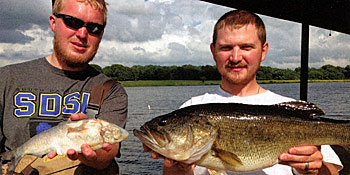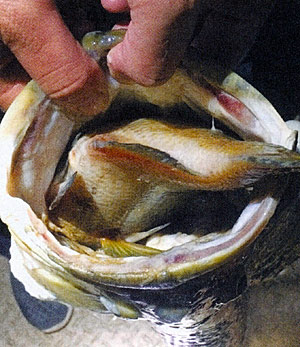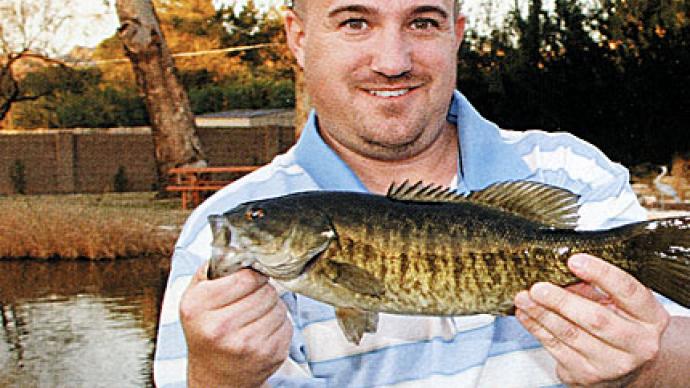
In our last article, I briefly discussed the large habitat enhancement project we are currently evaluating. I also mentioned that one of the commonly re-occurring patterns we've noticed during fieldwork is that the growth and condition of large-sized Largemouth Bass has improved. These results shed some light on our primary research question: "How much habitat is needed to increase production of largemouth bass, either in terms of abundance or growth?" The habitat enhancement project resulted in an increase of structural habitat to about 13% of the littoral shoreline. We may already be seeing increased production in the population based on the larger sized individuals. For this article however, I want to discuss some of the pathways by which structural habitat may be facilitating improved growth in our Largemouth Bass population.
The amount fish can grow is more easily understood by focusing on the amount of energy acquired and expended. Energetic budgets of fishes are similar to bank accounts. Fish gain all of their potential energy from prey. These are the inputs or the deposits. Then, fish make withdrawals and spend energy on maintenance. This includes metabolism and the internal organs and systems it fuels. The remaining balance, or extra energy in the account after maintenance is the amount available for growth. Another way to think about it is, first you have to pay the internal bills before you can spend energy on growth. When we think about the energy budget as it relates to habitat, we hypothesize there are a couple of potential pathways by which Largemouth Bass can benefit from increasing the amount of structural habitat.
First, structural habitat can aid in foraging by providing easy access to prey; this pathway would increase the deposits into the account. The other pathway would reduce some of the energy costs to bass by decreasing their activity. Structural habitat may provide the resources a Largemouth Bass needs in a smaller area, resulting in decreased activity and/or movement, which are large maintenance costs.

To understand areas Largemouth Bass use and their movement patterns, we are using a technique called radio-telemetry. We used electrofishing to capture approximately 30 large adult Largemouth Bass (mostly females) and surgically implanted a radio tag in the body cavity of each bass. Every radio tag transmits a pinging noise on a unique channel (similar to different radio stations), which allows for separately identifying and tracking individual fish. To locate the fish, we use an antenna and receiver box to pick up the noise from each radio channel. We travel in the direction the antenna is facing that produces the loudest ping, and continue moving in that direction until the noise is the loudest, indicating we are very close to the fish. Once we are close to the fish, we move around and triangulate the exact location of the fish and mark the location using a GPS unit. We locate each fish twelve times in a three-month seasonal period to quantify the size of seasonal use areas. Additionally, we measure activity on a finer scale by locating five fish every 4 hours in a 24-hour period. This sampling measures the distance moved in one day, and the sampling occurs 3 times per season.
First we will discuss movements of Largemouth Bass. Bob Lusk described this population of Largemouth Bass as "marathoners" before the habitat enhancement project. As you might guess, the term "marathoners" referred specifically to the large movement we observed prior to adding habitat. We know that excessive movement limits growth potential, because the energy that could be used for growth may instead be spent maintaining high activity costs. So, maybe increasing habitat will decrease movement, and corresponding activity costs, and promote improved growth of adult Largemouth Bass.

Our results one year post habitat enhancement have not provided support for the decreased activity cost hypothesis. We continue to see large daily movements of Largemouth Bass, with the largest movement being observed at over 2 miles by one individual in a 24-hour period. Seasonal use areas, or the area of lake being used by an individual Bass for important 3 month seasonal periods, also remained high with some Bass using more than 50% of the 110-acre lake during the prime growing season. Additionally, the average size of seasonal use areas remains between 8 and 13 acres, which is similar to the size of seasonal use areas observed before the habitat enhancement project. This tells us that growth due to decreased activity of Largemouth Bass is not expected in the short term.
What about the other side of the energy budget? In addition to telemetry, we also are tracking foraging patterns of bass to see if their diets changed after adding habitat. We know from previous work in our study lake that crayfish alone cannot maintain baseline needs for large adult Bass. These large predators need fish prey, and lots of them, to provide excess energy for growth. So we know that the more frequently fish are observed in diets, rather than crayfish and insects, the higher the growth potential will be in our population. Before the habitat treatment, Largemouth Bass diet samples frequently had remnants of less energetic prey items, such as crayfish. This gave us hope that the prey source could be improved and coincidentally growth potential improved. Habitat could provide key ambush points for more efficient capture of fish prey and/or increase frequency of consumption; both of which would increase available energy for growth. Post habitat-treatment diet samples have not been fully processed yet, so we cannot say whether either of these mechanisms has changed. However, we do have some interesting observations. During the post-habitat period, we have frequently collected large bass with diets made up of large energetic fish prey. For example, we collected a 4.2-pound bass eating a nearly 1-pound Tilapia, which is the first verified Tilapia collected in a diet in the five years of research on the ranch. And in another case, we collected a 6.6-pound bass with a Gizzard Shad in its stomach that weighed over a half pound. We are excited about these observations, and we are eager to see the whole energetic picture when we finish processing the diet samples. Stay tuned.
What are we learning about the science of habitat? Our population is heading in the right direction, and we are getting closer to sorting out the mechanisms. Structural habitat may be providing missing resources needed to achieve our management goal of a trophy Largemouth Bass fishery. The structure does not appear to be decreasing movement rates and or distances, but may be improving foraging. This potential increase in energy inputs may already be evident in the population as we see upward trending growth and condition of large fish. But, it seems that covering more than 13% of shoreline may provide even greater benefits to fisheries. More structural coverage may increase mechanisms for population improvement. For example, perhaps 30% coverage is needed to promote decreased movement and activity costs, which might further increase growth potential. Research continues to find the sweet spot for structural coverage in ponds and reservoirs.
Large-scale habitat enhancement projects may be important tools for improving fisheries in systems with little structural complexity. This can include ponds that are showing symptoms of aging, such as decomposition and loss of woody habitat. Moreover, those of you with newer ponds, or in the process of building ponds, don't forget to develop a habitat infrastructure.
Reprinted with permission from Pond Boss Magazine



